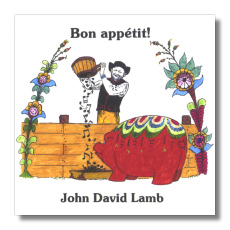
The Internet's Premier Classical Music Source
Related Links
-
Other Album Notes:
Late Harvest
Swedish Design
Bird's Eye View
Callithumpian Concert
Saxophone Project
-
Find CDs & Downloads
Amazon - UK - Germany - Canada - France - Japan
ArkivMusic - CD Universe
Find DVDs & Blu-ray
Amazon - UK - Germany - Canada - France - Japan
ArkivMusic-Video Universe
Find Scores & Sheet Music
Sheet Music Plus -
Recommended Links
Site News
Liner Notes
John David Lamb - Bon appétit!

NÄCKENS VÄNNER NV-4
Sorrow's Turning was originally composed in 1987 as a memorial to a gifted musician who died too young. In 2002 I revised the work, making it more compact and at the same time broader in meaning. The single movement follows the difficult path of grief: denial, anger, reconciliation, and loving remembrance. It is scored for fourteen winds and percussion.
Sketches is a suite for unaccompanied trombone composed in 1966 when I was living with my family in a cabin out near the coast in Northern California. This was a joyful and productive period that gave rise to larger works that came later.
The Antique Dances date from the early sixties and were originally for recorder, a spinoff of my interest in Renaissance dance forms. It soon turned out that the pieces worked especially well for saxophone, and that is how they are published and played. On this recording they are performed on a C-tenor saxophone, a particularly happy choice. The tambourine part was improvised and adds a nice neo-Renaissance touch.
In 1960 I met the great saxophone virtuoso, Sigurd Rascher, who according to his custom asked me to write something for him. The result was the Barefoot Dances. Rascher and his daughter performed them widely in the sixties and they have since been passed on to generations of students including Paul Cohen and Daniel Gordon who have played them countless times. The six short playful movements represent the first music where I felt that I had truly found my own voice, and the seeds of nearly all my later work are to be found here.
The Chorales, from the seventies, were meant to be played by any three instruments of similar range. I wanted to write music that made use of the Baroque chorale and variation form. These two are part of a set that seems to work perfectly for saxophones: two tenors and a baritone.
Madrigal, from 1972, is a friendly look back to the Elizabethan vocal style. One could well imagine text to this piece, and except for a boistrous instrumental outburst in the middle, it could easily be sung. It was composed for members of the Rascher Quartet who recorded it in the mid-seventies.
On Vacation for organ and brass (2001) was intended for a summer Scandinavian tour that never came to pass. By the time the tour was cancelled, the piece was well beyond the sketch stage and I was persuaded to finish it as planned. This explains the elaborate program that follows.
Summers are very special in Scandinavia, and it was easy to let the music take on the mood of a vacation in a land where the summer days are long and the nights are magical twilight. I imagined a family taking off for a month of camping, carnivals, carousels, and carefree times.
First comes the carnival scene with fanfares and showmanship. The dominant motive becomes the waltz-like music of the carousel and the graceful up-and-down movement of the wooden horses. The organ attempts to imitate the wheezing mechanical sound of the merry-go-round.
Now imagine the family camped on the edge of a Nordic forest where in the middle of the night, the half-light reveals all sorts of super-natural creatures, some evil, some merely strange, and all mysterious. Papa tells stories, and one can imagine some scary things that go bump in the night. But it is all make-believe, and after all the atonal bumps, the organ plays a "whistling-in-the-dark" tune to show that nobody is at all scared, and everybody drifts off to sleep, safe in the arms of D-flat major.
The last movement is set in a typical small-town folk park with a band and an outdoor dance platform. Hambo and polka alternate with children's games. In one game the children huddle with their heads down waiting for a whooping signal in the music. Then they jump up, shrieking with laughter, and dance around in a ring. Toward the end of the movement a few of the dancers have enjoyed a little too much akvavit, but they pull themselves together and dance joyfully to the end.
As my Swedish fiddle teacher used to say: Njut, för helvete!

Credits
Art – Sydney Stibbard
Recording, editing and mastering – Al Swanson
Sketches recording – Tom Fallat, Sound Sound, Seattle
Barefoot recording – Sonata, NYC
Organ – St. Stephen's Episcopal Church, Seattle
Production – J.D. Lamb
All selections licensed by ASCAP
Published byNÄCKENS VÄNNER
1907 East Blaine
Seattle, WA 98112
©® 2005 by John David Lamb













